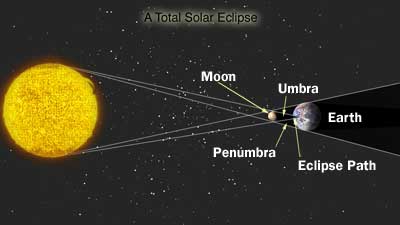

Introduction:
The total eclipse of the sun is an extraordinary and majestic event. It testifies to the remarkable arrangement of our solar system and more particularly the special relationship between the earth, its moon, and the sun, which allows life as we know it to exist on our world.

Earth:
Because the earth's orbit is basically circular, the seasons are due to the tilt of its axis of 23.5 degrees. If there were no tilt, all climactic variation would be due to latitude and life would exist in a very narrow temperate band. If the tilt were more pronounced, seasonal changes in each area would be so vast that it would be difficult for life to survive: sea levels would rise and fall sharply with the immense changes in the polar ice caps; there would be stronger winds and storms.
The pull of the sun and moon upon the earth creates an equatorial bulge and causes the rotation axis of the Earth to precess slowly around the Pole of the ecliptic every 26000 years. This means that we did not always have the same polar star. In 125 bc, Hipparchus said, "at the pole these is no star at all", and in 12000 years, Vega will take its turn as the closest star to the pole.
More important than this effect of the earth's precession is the resonance of this movement, which leads to small changes in the obliquity of the ecliptic (the tilt of the earth's axis). Only a 1-degree shift of the earth's tilt explains the occurrence of the ice ages. Moreover, calculations show that the Earth's axis should have changed drastically (up to 65 degrees) due to this perturbation, making it a hostile place for live to exist. Fortunately, the large size of the moon creates a stabilizing effect on the earth and thus almost cancels out the disastrous effects of the combined resonance over long periods of time.
Moon:
No other planet in our solar system has a moon so large in relation to its size (except for the special case of Pluto and Charon). At a distance of only 60 times the earth radius (an average of 380,000 km), the moon is also quite close. The waxing and waning of the Moon is the most impressive sight in our night sky and vestiges of its effect on life upon this planet are ubiquitous.
The moon is imprinted upon all living things in ways that are obvious and others more subtle. The pull of the moon creates tides, the monthly menstrual cycles in primates, and permeated our myths, traditions, art, and theology.
The moon's phases are due to its orbit around the earth and the reflected light from the sun. Although ½ of the moon is always illuminated, the part we see illuminated varies. At full moon we see the full half of the moon reflected and at "new moon" we cannot see the moon at all. The moon rotates around itself in perfect synchronization with its revolution around the earth so the same side of the moon is always facing us.
